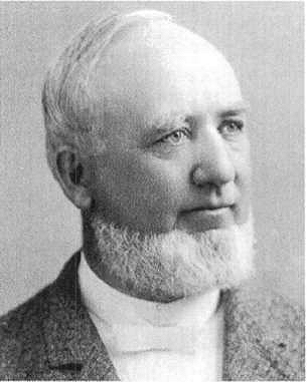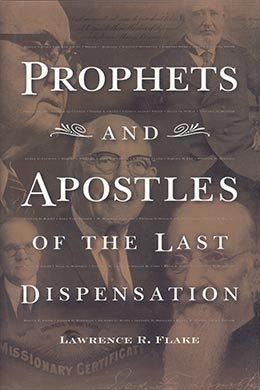George Quayle Cannon
Lawrence R. Flake, Prophets and Apostles of the Last Dispensation (Provo, UT: Religious Studies Center, Brigham Young University, 2001), 181–85.

Born: 11 January 1827, Liverpool, Lancashire County, England
Quorum of the Twelve Apostles: 26 August 1860 (age 33)
Additional counselor to President Brigham Young: 8 April 1873
Assistant counselor to President Brigham Young: 9 May 1874
Returned to the Quorum of the Twelve: 29 August 1877
First counselor to President John Taylor: 10 October 1880
Returned to the Quorum of the Twelve: 25 July 1887
First counselor to President Wilford Woodruff: 7 April 1889
First counselor to President Lorenzo Snow: 13 September 1898
Died: 12 April 1901 (age 74), Monterey, California
One night in Liverpool, England, a boy lay weeping in his bedroom. His was not a sorrow caused by the common disappointments of a child’s everyday life, but by a sadness born of a deep spiritual longing: “I have wept because I did not live on the earth when Jesus wandered among men. And I have asked myself, why is it that men cannot receive those blessings as they who were the associates of Jesus received them? I asked my teachers, and I asked my parents, ‘Are there men now who receive these blessings?’ and they answered me that there were none, and I wondered why it was so.” [1]
The good news of the restored Church of Jesus Christ could scarcely have fallen on a more responsive soul than that of young George Q. Cannon. [2] He learned the gospel from his uncle John Taylor, who came to his parents’ home from Canada as a missionary in 1840. Two years after joining the Church, the Cannon family of eight set sail for Zion, which was then established in Nauvoo, Illinois. Sister Cannon, in fulfillment of a premonition both she and her husband had, died at sea. [3]
Upon reaching Nauvoo, fifteen-year-old George had a powerful experience when he first caught sight of the Prophet Joseph Smith. Brother Cannon wrote: “When his [the author’s] eyes fell upon the Prophet, without a word from anyone to point him out or any reason to separate him from others who stood around, he knew him instantly. He would have known him among ten thousand. There was that about him which to the Author’s eyes, distinguished him from all the men he had ever seen.” [4]
George’s father died shortly after he established his family in Nauvoo. George, now an orphan, was apprenticed to his Uncle John Taylor’s print shop and helped with the publication of the Times and Seasons. This effort was the beginning of a long and distinguished literary and publishing career.
Living through all of the drama of the Nauvoo persecutions and martyrdom of the beloved Prophet, George Q. Cannon moved west with the first large company of Saints in 1847. It was on this journey that he met twelve-year-old Elizabeth Hoagland, whom he later married.
George described the first year in the valley as one of great hardship—the roofs of their homes, built on the inside wall of a fort, leaked miserably, and food was scarce. Even oxen that had been killed and partially devoured by wolves were salvaged for what meager sustenance remained on their carcasses. George wrote about eating thistle tops, which had no nutritional value: “To have the stomach full was an agreeable sensation, even if the contents were only thistle tops.” [5] In 1849 he was called by Brigham Young to accompany a group of missionaries to California to obtain much-needed funds for the Church by digging gold. From San Francisco he set sail to Hawaii to fulfill the second of five successive missions, which would last a total of fifteen years. During this mission, at a time of deep despair when most of the other missionaries were giving up and returning to the mainland, Elder Cannon was blessed with the most sacred of all manifestations. He went into a garden and prayed to the Lord more ardently than he ever had: “It was here that he talked with the Lord, heard His voice and felt His holy presence. This was such a sacred experience that he seldom made any public reference to it. It remained with him all his life. His dying testimony to his son who sat by his bedside in his last hours was that he knew that God lived, for he had heard His voice.” [6]
Following this great strengthening of his already strong testimony, Elder Cannon seemed clothed for the rest of his life with spiritual power. He completed his mission, having received through the gift of tongues the ability to speak the language.
After a five-year absence from the Salt Lake Valley, he returned, married Elizabeth Hoagland, and answered the call of another mission to San Francisco, this time to publish the Western Standard, a newspaper defending Mormonism. Shortly after the loss of their firstborn son, the Cannons returned to Utah to prepare for the invasion of the U.S. Army. A few weeks later Brother Cannon was called to serve a mission in the East and soon became a chief executive in the Church’s mammoth emigration operation. It was during this eastern mission that he learned of his calling to the Quorum of the Twelve. He was ordained an apostle upon his return to Salt Lake City in August 1860. In his first assignment in this capacity, he voyaged to Great Britain, where he published the Millennial Star and presided over the mission. As the first step in his role of statesman, he visited Washington, D.C, on 18 May 1862 from England at the request of President Brigham Young to participate in the long struggle for Utah’s admission to the Union.
In 1864 Brother Cannon returned to Utah, where he served as private secretary to Brigham Young for three years. In the winter of 1864–65 he devoted his outstanding executive talents to the organization of the Sunday School, the far-reaching influence of which is incalculable. In connection with this endeavor, he began the publication of the Juvenile Instructor and also edited the Deseret News. From 1867 to 1882 Elder Cannon was engaged in various political activities, including more trips to Washington in pursuit of statehood for Utah and five terms as congressman. His political career ended in 1882 when his seat in the House of Representatives was denied him because of his acceptance and practice of plural marriage. In the following years he helped promote a number of successful business ventures in Utah including ZCMI, Brigham Young Trust Company, the Union Pacific Railroad, and Utah Power and Light Company. He continued to write voluminously, using even the prison terms he was forced to serve—which were a result of practicing polygamy—to further his literary endeavors. Brother Cannon had the privilege of serving as a counselor to four presidents of the Church—Brigham Young, John Taylor, Wilford Woodruff, and Lorenzo Snow.
Missionary, statesman, author, and business magnate, Elder Cannon was eulogized at his death by newspapers across the nation as second only to Brigham Young in having an impact in the transfiguration of Utah from a sage-covered prairie to a prosperous state of the Union. [7] An example from the Boston Globe read: “The Death of George Q. Cannon removes from the sphere of worldly activities a Mormon leader who was second in power and influence only to that born ruler, Brigham Young himself.” [8] His impressive record as a man of letters, a congressman, the beloved head of a family of forty, and an apostle of the Lord Jesus Christ for forty years won him the admiration of many, but none was so quick to acknowledge his dependency upon and devotion to the Savior as was this powerful and brilliant man. Brother Cannon’s witness of Christ’s reality stands as a moving testimony to the force behind all the efforts of his lifetime of service to the kingdom: “I know that Jesus lives; for I have seen him. I know that this is the Church of God, and that it is founded on Jesus Christ, our Redeemer. I testify to you of these things as one who knows.” [9]
Notes
[1] Millennial Star, 6 September 1862,563.
[2] Matthias F. Cowley, Prophets and Patriarchs of the Church of Jesus Christ of Latter-day Saints (Chattanooga, TN: Ben E. Rich, 1902), 152–65. See also Davis Bitton, George Q. Cannon: A Biography (Salt Lake City: Deseret Book, 1999).
[3] Lawrence R. Flake, George Q. Cannon: His Missionary Years (Salt Lake City: Bookcraft, 1998), 17–18.
[4] George Q. Cannon, The Life of Joseph Smith, the Prophet (Salt Lake City: Deseret Book, 1986), xxvi.
[5] Juvenile Instructor, 20 December 1873,203.
[6] Bryant S. Hinckley, The Faith of our Pioneer Fathers (Salt Lake City: Deseret Book, 1956), 163.
[7] Flake, George Q. Cannon, 5.
[8] The Boston Globe, 13 April 1901.
[9] Joseph E. Cardon and Samuel O. Bennion, comp., Testimonies of the Divinity of the Church of Jesus Christ of Latter-day Saints (Independence, Mo.: Zion’s Printing & Publishing Co., 1930), 87.
